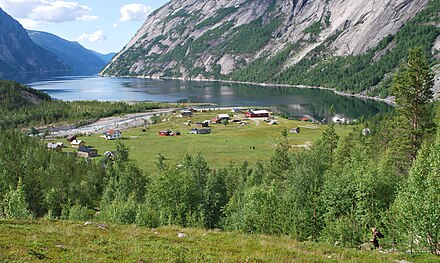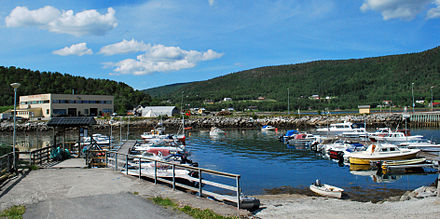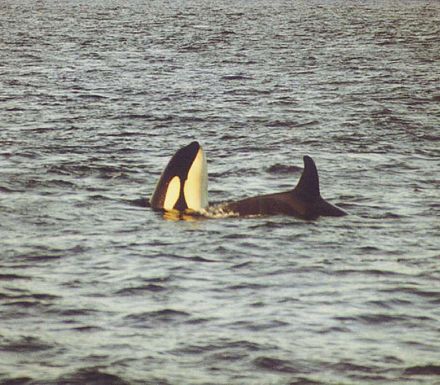Tysfjord - former municipality in Nordland, Norway
Tysfjord (Lule Sami: Divtasvuodna) is a former municipality in Ofoten in Nordland. The centre is Kjøpsvik.
Understand

Tysfjord lies around the fjord of the same name south-west of Narvik. Fells rise steep up from the fjords, and traditionally the population lived in small villages at the shores or in narrow valleys between the fells, with the waterways along the fjords providing contact with the outer world. Some of the fell areas are important reindeer pastures.
The main population centres are Kjøpsvik, Drag, Storjord, Musken, Hellandsberg and Korsnes. The municipality belonged to the district Ofoten, earlier to Salten, with which it still often is associated. With the municipal merger, the areas north of the Tysfjord fjord now mostly belong to Narvik, those south of it to Hamarøy.
Sámi is an official language (since 2006, although the Sámi have lived here since times immemorial). Tysfjord was the only municipality with Lule Sámi an official language.
The fishing is rich, with lobsters (the most northerly in the world) and big herring winter catches. Orcas also use this resource, and there are orca and eagle "safaris".
Settlements

Kjøpsvik (Lule Sámi: Gásluokta) was the main village of the municipality. It has some 830 inhabitants. Cement factory. Church. Ferry connection with Drag along road 827 and to some minor settlements.
Korsnes (Lule Sámi: Hierggenjárgga), with some 50 inhabitants, is reachable by road, with a junction from E6 2 km before Bognes ferry quay. The former main church of Tysfjord was moved here in 1888. The regional Museum Nord has one of its museums here.
Storjorda or Storjord (Lule Sámi: Stuorgiedde), with some 200 inhabitants, is also near Bognes, 2 km to the south with road from E6. Accommodation in Tysfjord Turistsenter.
Drag (Lule Sámi: Ájluokta) has mining, church, the Sámi centre, and sports facilities. 4,5 km from E6 by road 827. Ferry to Kjøpsvik and several minor settlements.
Helland or Hellandsberg (Lule Sámi: Ájládde) at the mouth of the Hellmo fjord is 5 km south-east from Drag, with road connection along the fjord. Former ferry quay. 3,5 km trail to the Tennvattnet lake.
Musken (Lule Sámi: Måsske) is halfway along the Hellmo fjord, The population has decreased fast, from 90 in 2003 to 20 in 2019, and the school was closed 2009. At most it had 23 pupils. Ferry from Drag.
Hellmobotn (Lule Sámi: Vuodnabahta) is at the end of the Hellmo fjord, with ferry connection from Drag via Musken. From here Sweden is only 6 km away.
History
In the early 17th century most inhabitants were Sea Sámi (97 of 98 tax payers), mostly living from fishing. From the 1660s Norwegians started to set up farms. In the 18th century there were inns in Korsnes and Kjøpsvik and into the 20th century Korsnes was a trading place with a post and telegraph office and a steamship quay. 1918 a cement factory started operation in Kjøpsvik, with raw material from the nearby limestone quarry. The factory is now the biggest employer in Tysfjord.
Get in
By plane
The Narvik/Harstad Airport (IATA: EVE) in Evenes is the closest one.
By bus
There is a services along E6 (between Fauske and Narvik) once or twice a day.
From Narvik there are some direct services to Kjøpsvik. To get from Fauske to Kjøpsvik you have to transfer to that service in Sætran (or at the junction), where there is a long wait, or get off at the Drag junction (Drag kryss), with a walk or transfer to local bus for the ferry from Drag.
By car
E6 goes through Tysfjord, with the only ferry on that road going across the fjord (25 min), from Bognes on the south side to Skarberget on the north side. Turn to the parallel road 827 for Kjøpsvik, Drag and ferries to minor settlements.
From Sweden, Tysfjord can be reached by E10 to Narvik and then along E6.
By train
The Malmbanan railway from Sweden ends in Narvik. The closest station on the domestic railways is Fauske (near the terminus Bodø). Narvik and Fauske are both on E6.
By foot
The Grenseleden trail leads over the fells from Gällivare in Sweden to Sørfjorden in Tysfjord, another route to Hellmobotn, only 6 km from the fjord to the border. Both trails are through very demanding terrain, see Do below.
Get around

The main roads in Tysfjord are E6 and road 827. The latter goes from Sommarset on E6 via Drag and a ferry (45 min, 9 times daily) to Kjøpsvik and continues to the north-east to Sætran, where it again meets E6.
Many of the minor villages lack road connection. Some of these have ferry connections with Drag and Kjøpsvik, for the rest you might be able to have somebody fetch you or join somebody going there, check locally.
By car
By boat
There are road ferry connections between Bognes (south-west) and Skarberget (north-east) on E6 (25 min), from Drag (south-west) to Kjøpsvik (north-east) on road 827 (45 min). Ferries to minor settlements mostly leave from Kjøpsvik or Drag. Ferries to Kjerrvika, Hulløyhamn and Storå have to be reserved in advance,
By bus
By bicycle
On foot
See


The main sights are the fjords and fells on one hand, and whales (orca) and eagles on the other. Tours available. There is also a cave, Råggejávrrerájgge, which is the deepest in Scandinavia.
- Árran. National Lule Sámi centre, with museum, day care centre, language centre and research. Offices of Sametinget and NRK Sámi.
- Stetind (Stádda). An important landmark for seafarers, elected Norway's national peak by a radio channel. . A good view probably requires climbing some other fell side or getting to a location across the fjord, such as Stefjordsneset.
- Museum Nord Tysfjord, NA°, NA°.
Churches
- Kjøpsvik kirke. The main church, built in 1975, made of concrete.
- Drag/Helland kirke. Wooden church built 1972.
- Korsnes kirke. This wooden church was originally built as chapel on Kjøpsnes (in Kjøpsvik) in the 1720s. It was moved to Hulløya in 1791. When it was moved back in 1838 it was enlarged. In 1888 it was moved to Korsnes, as it was thought too small for Kjøpsvik. The altarpiece is from 1888, with a painting completed in 1952.
Do

- Grenseleden (Rádjebálges). 24 h daily. A historic trail used for trade across the border to Sweden, this route was also used by refugees during the German occupation during World War II. The Germans investigated the fell passes, but deemed this one so demanding, they thought any refugees trying to use it would perish, so it was not well watched. Some 3,000 refugees used the route, guided over the fells by local Sámi. The trail was revived as a trekking route, officially opened in 2007. Boat transport to Sørfjorden (+47 75-77-43-29 ), call well in advance to allow coordination with other travellers. Another route goes to Sweden from Hellmobotn, which is served by ferry from Drag (at least part of the year). The latter is at Norway's narrowest point, just some 6 km from the fjord to the border. It was deemed easier and bunkers of German watch posts can be seen en route. Both routes are through remote fell areas.
- Bekkenesholmen. The second nature reserve in Norway (1928). A barren and quite steep island with fir wood. Accommodation by tent, food by camping stove. Free
- Bjørntoppen (Biertnačohkka). The highest peak in the municipality, at , with the Gihtsejiegŋa glacier. Long hike in demanding terrain. The Røysvatn DNT cabin is 3 km from the fell at , a 20 km hike from Sørfjorden, which you can reach by the Grenseleden boat. From Sørfjord you first follow a service road to a wind mill park, then a trail with discreet markings as common in Norway (the trail towards Paurohytta on the other side of the glacier forks off to the east north of Brynvatnet). The cabin is between Røysvatnet and Bjørnvatnet, while the marked trail may pass south of Røysvatnet. The cabin is wrongly marked on some maps.
- Råggejávrrerájgge. Limestone cave, 580 m deep and thus probably Scandinavia's deepest. It is possible to enter near the top of the cave, look out of it halfway and exit at sea level, but this requires technical climbing. There have been tours, check.
Buy
Eat
Drink
Sleep
Camping
Backcountry
As elsewhere in Norway, wild camping in utmark (away from developed land) is allowed according to the right to access. This does not cover car camping though – and in practice utmark means in the fells, with associated challenges.
For hiking trips, there are a few lean-to shelters on shorter trails and DNT cabins (unmanned, requiring the DNT key) a day apart on the longer trails.
- Paurohytta DNT cabin, 68.0490°, 17.0317°. DNT obetjent cabin; unmanned, DNT key and own linen needed. On the trails along the border. Non-members 400/200/100 kr, members 200/100/0 kr; by tent or day visit 100 kr
- Røysvatn DNT cabin, 67.9607°, 16.8330°. DNT obetjent cabin; unmanned, DNT key and own linen needed. On the trails along the border. Non-members 400/200/100 kr, members 200/100/0 kr; by tent or day visit 100 kr
Connect
Stay safe
Go next
- The long distance hiking trails Nordkalottruta, Grensesømmen and E1 Long Distance Path all lead along the border fells. They are reached by Grenseleden, the trail to Paurohytta or the trail from Hellmobotn (also called Grenseleden on some maps).
- Mo i Rana has a few more accessible great caves (and some less accessible, for real experts).
- The Lofoten archipelago is one of the highlights of visits to Norway. Ferry from Bognäs to Lødingen, with connection to Svolvær.
Tysfjord
tysfjord.kommune.noNordland
Primary administrative division